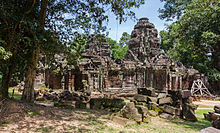Ta Som
Coordinates: 13 ° 27 '52.4 " N , 103 ° 54' 46.2" E
The Ta Som Buddhist temple in the Angkor Archaeological Park was built under Jayavarman VII (ruled 1181-1220) in 1190-1210 and expanded during the reign of Indravarman II (ruled 1220-1243). As a typical flat temple with a triple border, it is a “simplified miniature version” (after Freeman, Jacques) of the Ta Prohm temple. The jungle atmosphere and the eastern gopuram (face tower) with strangler fig are interesting for tourists. Large parts of the complex are ruins, some of which are still overgrown by vegetation.
In 1992, UNESCO declared the Angkor Archaeological Park , and thus also the Ta Som Temple located within this park, a UNESCO World Heritage Site.
location
The Ta Som Temple is located on the Grand Circuit within the Angkor Archaeological Park (Cambodia). The temple is located east of the Jayatataka Baray (also Eastern Baray), at the foot of the dike of this Baray. The temple is on an axis with the Preah Khan and the Neak Pean, 2.5 km north of Eastern Mebon and 1.8 km east of Neak Pean (13d27'52N; 103d54'46E).
Surname
The popular name "Ta Som" means "ancestor Som". Accordingly, King Jayavarman VII built the temple for his teacher and mentor Som . Some researchers have identified “Ta Som” as Gaurashrigajaratna : “Jewel of the lucky white elephant”. This name is mentioned in the stele of the Preah Khan temple as the home of 24 deities (see also section "History").
Site plan and structure
Like almost all temples in Angkor that were built during the reign of Jayavarman VII, Ta Som is also a typical flat temple with a concentric border (in contrast to the temple mountains, e.g. the state temple Bayon ).
Compared to other buildings from this period (Ta Prohm, Preah Khan, Banteay Kdei), Ta Som is one of the smaller temple complexes with a total area of 4.5 hectares. Building materials here are also the laterite and sandstone characteristic of Khmer buildings .
The site plan and structure of Ta Som Temple are simple. The Ta Som temple is laid out according to the typical construction principles of the Khmertemples: Axiality and symmetry .
- Ta Som lies on an east-west axis and has a triple concentric border. The main entrance to the temple, like most Khmertemples, was originally in the east, although today's main entrance for tourists is on the Great Loop in the west.
- An outer wall (240 × 200 m) with two gopuras (temple gates) surrounds a wide moat that is pierced to the east and west.
- Within this facility there is a second enclosure wall, which also has two entrances.
- The center of the temple complex forms the now collapsed, cross-shaped central Prasat (temple tower) with the central sanctuary, which in turn is surrounded by a concentric gallery and two so-called “libraries”. (Petrich, 2008) These structures were possibly used to store writings, documents and ritual objects.
With this site plan, the Ta Som Temple resembles the much larger monastery complexes of Ta Prohm and Banteay Kdei .
Michael Freeman and Claude Jacques concisely summarize the site plan and structure of Ta Som: Ta Som appears like a miniature simplified version of Ta Prohm or Banteay Kdei (Michael Freeman, Claude Jacques, Ancient Angkor , River Books, Bangkok, 2006, p. 182) .
history
Ta Som is one of the smaller structures built under King Jayavarman VII (r. 1181-1220) (cf. Bayon , Preah Khan ). The complex was built between 1190 and 1210 and can therefore be historically assigned to the last phase of the Bayon period.
Jayavarman's successor VII, King Indravarman II (ruled approx. 1220–43 / 44), had the complex enlarged and the third (outer) surrounding wall built.
Since there are no inscriptions in the Ta Som temple itself, it is problematic to determine the function of the Ta Som. The stele of the Preah Khan Temple provides an indication of Ta Som's function as a sanctuary for deities. The inscription speaks of “Gaurashrigajaratna”. This name means something like "jewel of the lucky white elephant". Some researchers identify Ta Som with Gaurashrigajaratna, whose function is mentioned in the inscription as the "home of 24 deities". (Freeman, Jacques, 2006)
Because of its somewhat remote location within the Angkor Archaeological Park, the temple was the victim of numerous art thefts in the 1990s . Traces of this can still be seen in the apsara and devata figures, some of which had their heads cut off. Bodhisattva Avalokiteshvara's face, facing west, used to be one of the most photographed objects in Angkor. It was overgrown by a huge strangler fig, which framed the face in a particularly picturesque way.
restoration
The Ta Som Temple is currently (as of 2008) being restored by the World Monuments Fund (WMF), under whose direction the Preah Khan Temple in Angkor has already been restored. No conservation work had been carried out since the 1950s.
literature
- Albanese, Marilia, Die Schätze von Angkor , National Geographic Art Guide, Hamburg, 2007.
- Freeman, Michael & Jacques, Claude: Ancient Angkor , River Books Ltd, Bangkok, 2006.
- Petrich, Martin H., Vietnam, Cambodia and Laos. Temples, monasteries and pagodas in the countries on the Mekong. DUMONT Art Guide, Ostfildern, 2008.




